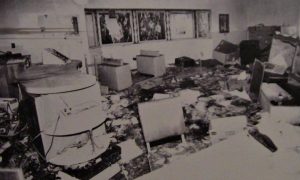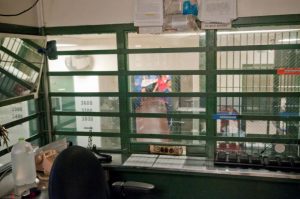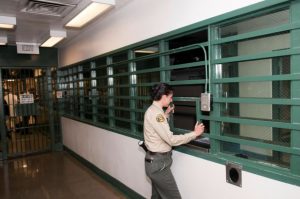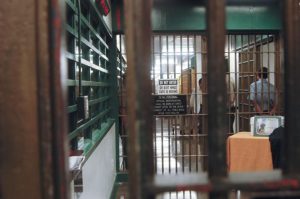New Mexico State Prison Riot
The New Mexico State Penitentiary, a maximum security facility near Santa Fe, was the scene of one of the most brutal prison riots in American history.
On a Saturday in the early morning hours of February 2, 1980, two inmates were drinking homemade alcohol and were caught by a prison guard. The inmates overpowered the guard and took four more officers hostage. One officer who fled accidently dropped his keys. This allowed the inmates to open the gates and release other prisoners from their cells.

The inmates attacked the master control center, which only had glass windows to keep the inmates out of the center. There were no bars over the windows. The inmates worked as a team, taking turns striking one of the windows with a fire extinguisher. At first a huge crack in the shape of a “Y” appeared in the window. The inmates persisted and were able
to break the window out.
Inmates streamed into the control center and took it over. This gave them access to the controls of the main door locks and gates, which allowed them to let inmates into restricted areas. The control center also held an arsenal of weapons, which the inmates removed and used to their advantage. There was also a locker of keys that gave the inmates access to other areas of the prison.

Some of the most violent inmates who had been locked in solitary confinement were loose and leading gangs of inmates to commit violence throughout the prison. Rival gangs were fighting and killing each other.
The inmates attempted to break into the protective custody unit, which held informants and inmates convicted of sex crimes. When they found their keys wouldn’t work, they located acetylene torches that were being used in a construction project. They spent five hours cutting through the bars.
Inmates were pulled from their cells and tortured. Some of the most horrific violence occurred during this time. Inmates were dismembered, decapitated, and burned alive. They were killed with knives, work tools, and pipes. One inmate was tortured and killed with a blowtorch.
The inmates from the protective custody unit could have been rescued but the state police would not enter the prison while prison officers were being held hostage.

After 36 hours, the riot was over. During that time, 33 inmates were killed and over 200 injured. The details of this ordeal were broadcast on news reports throughout the country. Lieutenant Mike Nelson, who was the Training Lieutenant assigned to
the Los Angeles County Sheriff’s Department’s Men’s Central Jail, watched the news in disbelief as he realized that this could also happen at Central Jail.
Men’s Central Jail
Lieutenant Nelson looked at the windows of the control booths inside Central Jail. The windows had wire mesh in the glass but they weren’t bulletproof. The wire mesh was supposed to keep inmates from breaking through the glass, but the New Mexico prison riot proved that theory wrong. Also, the windows on some of the control booths were up higher to make it more difficult for inmates to reach them. But what was learned from the New Mexico riot was that they could be reached and broken out by multiple inmates working together.

Lieutenant Nelson realized the vulnerability of these windows. He talked to the Captain and the Custody Division Chief and explained that the inmates inside Central Jail had seen the news and saw the New Mexico prison riot footage. The inmates realized that the Central Jail control booth windows could be broken out with fire extinguishers and trash cans, and that once the control booth windows were gone, the inmates could take over that part of the jail and let other inmates out of their cells. It would be complete chaos.
But the biggest concern, Lieutenant Nelson said, was main control. Central Jail’s main control was surrounded by windows that were at eye level. The windows could easily be broken out, and inmates could storm inside, where they would have access to gates leading outside the jail.

They would also have access to keys to every door in the facility. The communication system was run from main control and controlled all prowl phones throughout the facility. Weapons were also stored in main control in the event of a riot. Inmates would have access to all of these weapons. If main control was taken over, the jail would be lost.
The Captain of Men’s Central Jail and Custody Division Chief both said there was no money to install bars over the control booth windows. But Lieutenant Nelson was persistent. He told them he would investigate how much it would cost to purchase and install bars on every control booth in the facility.

Lieutenant Nelson, with the assistance of his training staff, measured all of the control booth windows in Central Jail to determine how many feet of flat bar steel ¼-inch thick it would take to protect the windows. He determined the cost to purchase the steel bars and got a bid from the Mechanical Department to install them. Installation required that workers bore threaded holes into the walls and bolt the bars across the windows, spacing the bars close enough so that a person couldn’t get through. The cost was less than $170,000.
The Department’s administrators felt that the need to install the bars was so critical that they funded the project. Once the project was approved, it took three months to complete the job.
Since that time, there’ve been several riots at Men’s Central Jail. None of the riots spread outside their immediate modules. Due to the concern and diligence of Department members like Lieutenant Nelson, LASD jails are much safer for both inmates and Sheriff’s personnel.
